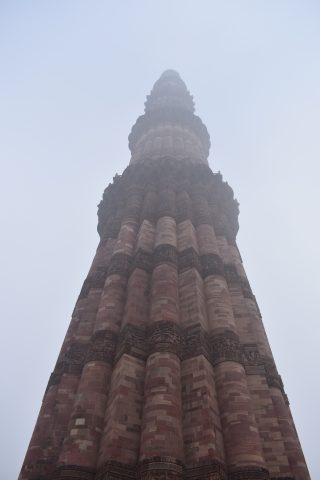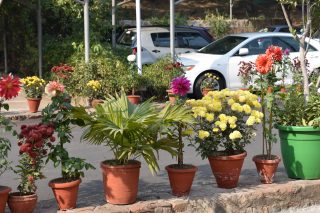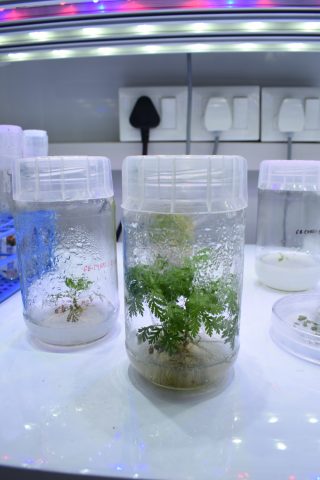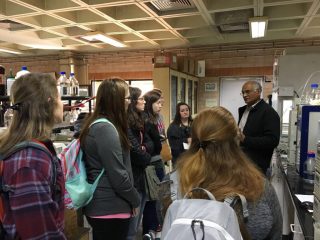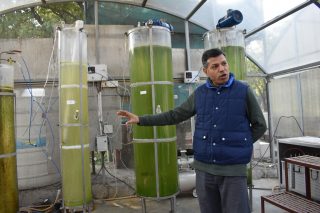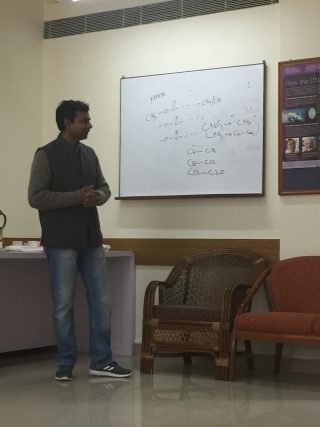Despite only four hours of sleep and some powerful jet lag, our experiential learning study abroad program in Indian agriculture wasted no time on our first day in country. We loaded the bus early in the morning for a cultural visit to Qutub Minar, a UNESCO World Heritage site in the center of Delhi. The 73-meter tower was covered in haze during most of our visit, but our tour guide was still able to remark about its impressive history. Many of the Islamic structures at the site (including the arches, the mosque, and parts of the tower) were built from pieces of surrounding, demolished Hindu structures. This was a great introduction to the blended culture and extensive history we would experience throughout the program.
From here, we proceeded to our first academic visit of the program at the International Centre for Genetic Engineering and Biotechnology (ICGEB). Even as our bus drove up to the main building, I could see from the distant greenhouses and the colorful flowers lining the driveway that these facilities were well devoted to different forms of agriculture. Our visit began with a small introduction from two student researchers and a short video about the mission of ICGEB. I was especially shocked to discover the reach of ICGEB as its main facilities are located in Trieste, Italy, Cape Town, South Africa and New Delhi, India with countless other experiments conducted in collaborating labs throughout the world.
From this lecture hall, the group climbed the stairs and entered a much smaller lounge. We sat in a collection of couches and chairs in the corner of the room and waited patiently while different lab leaders came from their labs to present about their current research. The scope of the Institute was re-emphasized here as well as I noticed that one of the walls was covered with over 60 flags of the member countries committed to the ICGEB mission. Eventually four lab leaders were able to discuss the main objectives of their labs as follows:
#1 – Bioinformatics Lab
Dr. Gupta stated that much of his research concerned the area of the newly popular field called bioinformatics. This field is where scientists try to discover how parts of the cell are able to effectively pass along a working message from DNA to protein via transcription and translation and to create different effects in the cell and the body. His work specifically focused on identifying changes to the genome that led to changes in proteomes of the cell, and then, he and his team of researchers tried to apply this knowledge to understanding how drug resistance occurs.
#2 – Structure of Biology Lab
This lab’s presentation made it seem like the most diverse. The researcher focused on using NMR (nuclear magnetic resonance) spectroscopy in order to uncover the structure and shape of various cellular proteins. He noted the importance in knowing the design of a molecule because in doing so, researchers can create an appropriate ligand for binding. This has implications notably in drug effectiveness, but the researcher also mentioned that his lab looked at getting signatures biofuels and understanding prognosis and diagnosis methods of different diseases.
#3 – Malaria Biology and Treatment Lab
Dr. Sahal began his presentation by noting the significance of malaria research in India. He described it as a “poor man’s disease” because of it’s prevalence primarily in third-world and developing countries. I had the chance here to ask more about the mechanism of parasitism in red blood cells, and Dr. Sahal’s response covered everything from means of entry, chemical conversions, and drug resistance.
He also pointed to the difficulty of creating effective vaccines as the parasite had so many biological markers (about 260 known). Currently, the most common anti-malarial drugs are artemisinin and chloroquine, and often these are used in combination with other drugs. However, he explained that even the most effective combinations have only about a 30% efficacy for the general population. This means that in regions densely populated with mosquitos and in regions lacking public knowledge of environmental mosquito control methods, there is still a high chance of malaria parasitism and persistence.
During the subsequent visit to his lab, we had the chance to observe some of the technology that the researchers utilized to test vaccine efficacy including activity guided chromatography, a UV-Vis spectrometer, a very fine-tuned balance, and gel electrophoresis. One notable feature of this lab was that many of the participating research students were from different regions in India and different countries. Dr. Sahal said that many of them brought different drugs or natural products from their countries that they thought might prove effective as an anti-malarial drug which was a unique way to receive new suggestions for testing material. I was also very impressed with the lab’s mammalian cell culture lab because its presence meant that the lab sped up the research time by testing the specificity and safety of the samples in house.
#4 – Biofuels Lab
This lab’s research was personally the most noteworthy since the depth of the topics were relatively unfamiliar but drew from some basic chemistry principles. Dr. Rhode’s lecture was the longest of the four, but I appreciated how thoroughly he surveyed a complex topic. In a broad sense, he performs research in metabolic engineering but primarily focuses on engineering strains of algae with higher biodiesel production rates.
It was during this lecture that I learned the different classifications of biofuels: first generation (biofuels derived directly from human food sources like ethanol from corn), second generation (biofuels from non-human food sources like extracting a form of ethanol from wood chips or fruit pulp), and third generation (biofuels generated by algae). I also learned that algae has the potential to produce tremendous amounts of biodiesel, but limitations in research funding and current technology restrict our ability to effectively utilize this property. This research has huge implications for India in particular which continues to see a significant rise in the percentage of imported fossil fuels.
These lectures were the most impressive parts of our tour to ICGEB because from them, I learned so much about the scale and diversity of research in India. We also visited an algae-water purification unit and multiple greenhouses on the campus, but each of these stops were put into context by some aspect of the presenters’ discussions of their current work. I am grateful that this was our first acad emic visit in New Delhi as these presentations set the foundation and the tone for the some of the challenges we would witness different groups and institutions begin to confront.
